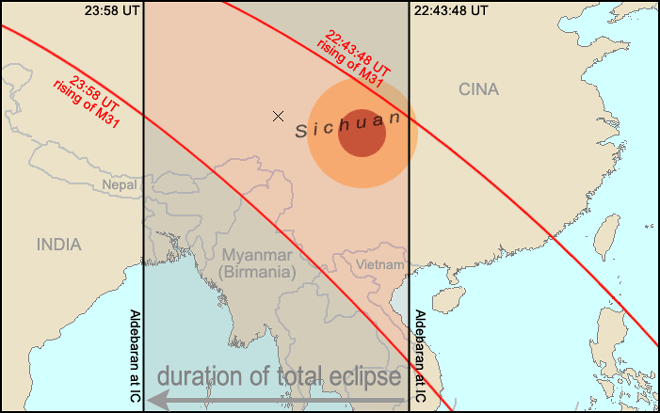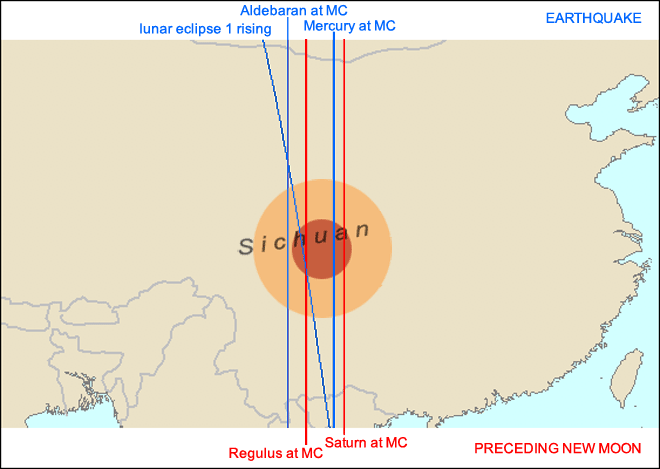|
Marco Fumagalli - The earthquake of western Sichuan
|
||||||||
|
The sky on the earth
|
||||||||
|
Why was exactly the region of Sichuan hit? Would have it been possible to locate the zone from the first eclipse? In the lack of a complete and well-tested system of astral chorografia [27], the only possible method seems to be the simple astrocartographical research, considering the transits of stars and planets in the angles, or the mutual position between stars and planets [28]. IIn this case, if we were considering the whole duration of the totality of the eclipse
10. The culmination of Aldebaran and the rising of Andromeda Now, for the moment of the earthquake, we trace the line of the rising of 12°42' Virgo, the degree of the first eclipsed moon, and the lines of the culmination of Aldebaran and of Mercury. Let’s add, for the preceding New Moon, the culmination of Regulus and Saturn. The result is the following:
11. Astrocartographical lines in the earthquake and in the preceding New Moon. The close astrocartographical examination, with the details of all the transits of the stars connected to earthquakes, for every eclipse visible on the terrestrial surface, is a huge work, however not impossible. By superimposing the results on a seismographic map, we should be able to localize the zones that the astrologer considers more dangerous in the successive times. And it would be only the start of the work: for each zone in fact it would be necessary to draw up a map of the successive reminders following the eclipse, in a continuous evolution. This study intends to trace a direction for further researches, in a field in which there is still a lot to discover. The comparative study of a great number of earthquakes will allow a complete analysis of the various ways in which the figures are connected between themselves: only then the laws [30] which rule these events will emerge, the possibility of prediction remaining the primary aim of an astrological investigation [31]. [27] The Ptolemaic system, based on the triplicity of the sign in which the eclipse occurs, was not accepted by the Arab astrologers, in particular by Abû Ma'shar. Anyway, today it would be inapplicable to the parts of the world unknown to Ptolemy. [28] An example of a transit of Sirius with Saturn is found in Sirio, Saturno e Marte nell’eclisse lunare precedente il maremoto, «Phos» 10, p. 1 ss. (Sirio, Saturno and Mars in the lunar eclipse preceding the tsunami). [29] The involved zone is also composed of Myanmar, that was hit by the Nargis cyclone on the 2nd of May 2008, ten days before the earthquake of Sichuan. In the region devastated by the cyclone, the delta of the Irrawaddy river, Aldebaran was passing in transit on the inferior meridian a little after the centrality of the eclipse. [30] Although it’s too early to formulate its rule, a law that we begin to foresee could be called “the law of reversal”. In this earthquake we have seen some examples: the stars at the IC which present themselves at the MC, the rising degree which becomes a setting degree, the opposition between planets which come back in a reverse order , the angular planet that moves to the opposite angle. In the inversions along the angles, the ones which happen on the meridian seem to be the most powerful, and this is in harmony with the phenomenon: what is up ends down and it is from under the earth that earth itself is shaken. [31] At Milano, on a bimonthly cadence, a group of researchers of catholic astrology is active since more than one year; their scope is to experience the Ptolemaic methods with the help of the new instruments of calculation. Their names are: Giuseppe Bezza, Francesca Calabrese, Emanuele Ciampi, Antonino Denaro, Maria Antonietta Di Guglielmo, Françoise Moderne, Elisabeth Faucon Baraduc, Daniele Ferrero, Marco Fumagalli, Rosanna Piuselli, Simone Sebban, Patrizia Zivec. The work made here, which is mine, is also the fruit of ideas and experiences matured along with them. |
||||||||

